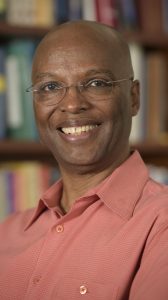
Electrical engineering alumnus Jerry M. Harris is the Cecil and Ida Green Professor of Geophysics at Stanford University. Submitted photo
When it comes to terrestrial understanding, University of Mississippi alumnus Jerry Harris (BSEE 73) knows the lay of the land.
As the Cecil and Ida Green Professor of Geophysics in the School of Earth, Energy and Environmental Sciences at Stanford University, the Sardis native teaches geophysical courses and directs the Stanford Wave Physics Laboratory, a research group on campus.
“My group includes students, postdocs and research scientists,” said Harris, who also earned his master’s and doctoral degrees in electrical engineering from the California Institute of Technology. “We work on seismic imaging for characterizing and monitoring Earth resources.”
Harris joined the Stanford faculty in 1988. During his tenure, he has served as chair of the Department of Geophysics, director of the Center for Computational Earth and Environmental Science, associate dean for academic affairs and associate dean for the Office of Multicultural Affairs, both in the School of Earth Sciences.
Prior to joining academia, Harris worked for 11 years in private industry with the Communications Satellite Corp., Exxon Production Research Co. and British Petroleum. He credited his continual career success to his beginnings at Ole Miss and described his career as a meandering stream rather than a pipeline.
“I chose Ole Miss because it was close to home and they offered me a band/music scholarship,” he said. “In high school, I liked building things, especially radios. Electrical engineering seemed like a good choice of major and had good job opportunities.”
Harris said his favorite engineering professor was Leonard Tsai.
“He was young, a minority and spoke the language of students,” he said. “His door was not just open; he invited me in to chat about academic issues and the social issues of the day, namely race relations on campus and in the country.
Other favorites of Harris were Chalmers Butler, with whom he did his senior thesis, and Damon Wall, who was “a friendly face” to all the students. They, and especially, Tsai influenced Harris’ career path.
“My undergraduate senior project on antennas gave rise to my interest in electromagnetics,” he said. “I went on to get a Ph.D. in electromagnetics from Caltech, though my interests shifted to wave propagation. My desire to become a professor was born from those chats with Leonard Tsai. While Ole Miss was not a very welcoming place for African American students in the early 1970s, Professor Tsai was a friendly voice in electrical engineering. Ole Miss Engineering not only prepared me academically but also helped to recognize the important role professors have in shaping the aspirations of students.”
Harris has received many honors and said they are meaningful for different reasons.
“I hold the Cecil and Ida Green Endowed Chair in Geophysics. Cecil Green was an electrical engineer whose company, Geophysical Services Inc., contributed to the introduction of digital electronics to the petroleum industry,” Harris said. “GSI spun off the now powerhouse electronics company Texas Instruments. I’m proud to be an electrical engineer [like Green] who found his career path in the field of applied geophysics for the petroleum industry.”
Being named Distinguished Lecturer for the Society of Exploration Geophysicists, American Association of Petroleum Geologists and Society of Petroleum Engineers are other honors Harris found fulfilling.
“These honors recognize my contribution to the development of the field of crosswell seismic imaging and also for the importance of the field to the industry of reservoir geophysics,” Harris said. “Lastly is the Stanford University Diversity Award, which was awarded to me (as cognizant dean) and the Office of Multicultural Affairs, in recognition of the summer pathways program SURGE that has helped numerous undergraduates from underrepresented groups get admitted to top tier U.S. graduate schools.”
Harris met his wife, Claudia (who also has a Ph.D. in geophysics), during his visit to the Brazilian national oil company Petrobras. Their son, Marek, is an undergraduate at Stanford majoring in human biology and planning to go to medical school. His daughter, Rashida, is a marketing executive with AT&T in Atlanta.